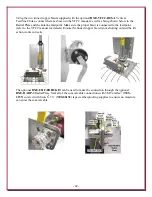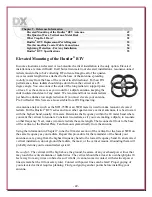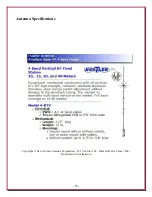
- 50 -
The Quarter-Wave Vertical on a Metal Roof
Over the years, many Amateur Radio operators have successfully used a metal roof as the ground
plane or radial system for their quarter-wave HF vertical antenna. This is possible with a metal roof
on a home, barn, garage, carport, RV, porch and metal sheds or awnings, and even on commercial
buildings. The actual height of the metal roof above ground is not especially important for an HF
quarter-wave vertical antenna.
In order to take advantage of a metal roof as a ground plane, you cannot elevate a quarter-wave
vertical high above a metal roof. The key is that the antenna feedpoint, which is usually at
the mounting bracket, should be the same physical level as the metal roof to offer the best ground
plane effect.
The feedpoint of the vertical should not be any more than 4 to 8 inches above the roof, even if the
mechanical mounting would allow for a higher installation. In other words, raising a quarter-wave
vertical antenna many feet above the metal roof does more harm than good with regard to
impedance matching and tuning. Mounting the HF quarter-wave antenna at the top of a tall mast,
without a feedpoint level radial system, does not function electrically, and is mechanically very
difficult. If you must use a tripod for mechanical mounting reasons, use one that is as short as
possible. With a tripod mount, you must use a basic wire radial system that emanates from
that slightly elevated feedpoint and drapes down over the metal roof to make use of the coupling
effect described below. You cannot make a direct connection of the coax shield to the metal, due to
the distance of the feedpoint above the metal.
There are
two ways
that a quarter-wave vertical can be installed on a metal roof or large metal
awning as a ground plane.
The potentially
less efficient
installation uses direct grounding of the coax shield and antenna
bracket to the metal roof. This might work well for transceiving, and would probably "appear" to
work well due to excellent receiving results. However, you may find that you aren't easily heard.
This would be an indication that the sections of your metal roof are not well bonded. Remember, we
are trying to provide the same low impedance RF current collection and distribution as a ground
mounted system of 30, or more, straight copper wire radials that are about one-quarter wavelength
long. Just because the metal panels of a metal roof are connected with a bunch of screws or nails,
and even when a multi-meter shows DC continuity between the panels, does not mean that you have
a good radial system for RF. You can try it and believe that it is working great, but you may not
really know how efficient the directly connected metal roof is working for you. Measured at the
antenna, a frequency range of over 400 kHz under a 2:1 SWR across and beyond the 40 meter
band (7.0 to 7.4 MHz) would be a general indication of radial system or ground plane inefficiency,
depending upon the size of the vertical. Conversely, a very efficient ground plane will narrow the
SWR bandwidth of a vertical, as narrow as 150 kHz on the 40 meter band on the BTV series
antennas.
The
preferred installation
for your quarter-wave vertical using a metal roof or large awning as your
ground plane is to connect the coaxial cable shield to several (6 to 16) insulated radial wires that are
placed on, under, or are draped out over the metal roof. The radials must be attached to the antenna
feedpoint, never at the bottom of a tall mast or tripod. Capacitive and inductive coupling between
the radial wires and the metal roof accomplishes the collection of the RF currents. The number of





























